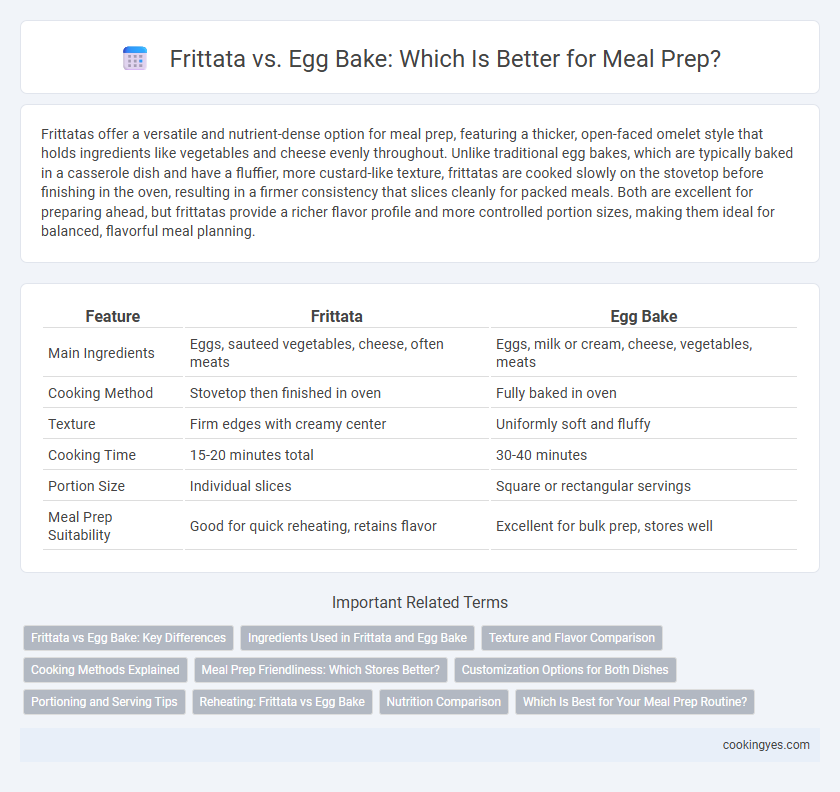Frittatas offer a versatile and nutrient-dense option for meal prep, featuring a thicker, open-faced omelet style that holds ingredients like vegetables and cheese evenly throughout. Unlike traditional egg bakes, which are typically baked in a casserole dish and have a fluffier, more custard-like texture, frittatas are cooked slowly on the stovetop before finishing in the oven, resulting in a firmer consistency that slices cleanly for packed meals. Both are excellent for preparing ahead, but frittatas provide a richer flavor profile and more controlled portion sizes, making them ideal for balanced, flavorful meal planning.
Table of Comparison
| Feature | Frittata | Egg Bake |
|---|---|---|
| Main Ingredients | Eggs, sauteed vegetables, cheese, often meats | Eggs, milk or cream, cheese, vegetables, meats |
| Cooking Method | Stovetop then finished in oven | Fully baked in oven |
| Texture | Firm edges with creamy center | Uniformly soft and fluffy |
| Cooking Time | 15-20 minutes total | 30-40 minutes |
| Portion Size | Individual slices | Square or rectangular servings |
| Meal Prep Suitability | Good for quick reheating, retains flavor | Excellent for bulk prep, stores well |
Frittata vs Egg Bake: Key Differences
Frittata and egg bake differ primarily in texture and cooking methods, with frittatas cooked slowly on stovetop before finishing in the oven, resulting in a dense, custard-like consistency, while egg bakes are typically mixed ingredients baked entirely in the oven for a fluffier texture. Frittatas allow for more visible, distinct layers of vegetables, meats, and cheeses, whereas egg bakes blend ingredients throughout the mixture. For meal prep, frittatas hold their shape better when sliced, making them ideal for individual portions, while egg bakes tend to be softer and easier to scoop.
Ingredients Used in Frittata and Egg Bake
Frittatas typically use whole eggs combined with a variety of fresh vegetables, cheeses, and meats, allowing for rich, customizable flavors. Egg bakes incorporate eggs beaten with milk or cream and are often combined with breads, potatoes, or other starches to create a denser texture. The ingredient differences influence both taste and consistency, with frittatas favoring less dairy and starch for a lighter, more open texture compared to the hearty, casserole-like egg bake.
Texture and Flavor Comparison
Frittata offers a denser, creamier texture with rich, custard-like eggs that perfectly meld with cheeses, vegetables, and meats, creating complex, layered flavors. Egg bake tends to be lighter and fluffier due to its higher milk or cream content and often includes baking powder, resulting in a more uniform texture and milder taste. For meal prep, frittatas hold up well without becoming soggy, preserving a more pronounced flavor profile compared to the softer, more tender consistency of egg bakes.
Cooking Methods Explained
Frittata is cooked slowly on the stovetop, often finished under a broiler to achieve a golden, fluffy texture, while egg bake is typically baked entirely in the oven for a uniform, dense consistency. The stovetop method of the frittata allows for gentle cooking and easy incorporation of ingredients, preserving moisture and creating a creamy interior. In contrast, egg bake's oven-only method ensures even cooking and simplicity, making it ideal for batch meal prep with consistent results.
Meal Prep Friendliness: Which Stores Better?
Frittatas store better for meal prep due to their dense, cohesive texture that maintains flavor and moisture after refrigeration, lasting up to 4 days in an airtight container. Egg bakes, being fluffier and more custard-like, tend to become watery and lose structure when reheated, making them less ideal for extended storage. For meal prep, frittatas offer superior shelf life and reheating quality, ensuring consistent taste and texture throughout the week.
Customization Options for Both Dishes
Frittatas offer extensive customization by allowing a wide variety of vegetables, cheeses, meats, and herbs to be mixed directly into the eggs before cooking, resulting in a dense and flavorful dish. Egg bakes provide flexibility through layering different ingredients such as bread, vegetables, and meats, which can be prepared in advance and easily portioned for meal prep. Both dishes accommodate dietary preferences and ingredient substitutions, but frittatas typically emphasize a uniform blend, while egg bakes focus on distinct texture layers.
Portioning and Serving Tips
Frittatas offer versatile portioning options by allowing easy slicing into wedges, making them ideal for controlled meal prep servings. Egg bakes, often baked in a casserole dish, can be cut into uniform squares or rectangles for consistent portion sizes. To serve, refrigerate individual portions in airtight containers for grab-and-go convenience, ensuring freshness and ease of reheating.
Reheating: Frittata vs Egg Bake
Frittatas retain their texture and flavor better when reheated due to their dense and cohesive structure, which prevents moisture loss. Egg bakes often become soggy or watery upon reheating because of their higher moisture content and looser consistency. For meal prep, frittatas reheat evenly in the oven or microwave without compromising quality, making them a superior choice over egg bakes.
Nutrition Comparison
Frittatas typically contain whole eggs and a variety of vegetables, providing a balanced source of protein, healthy fats, and fiber, which supports sustained energy release for meal prep. Egg bakes often include additional dairy products like cheese and milk, increasing calorie and fat content but also boosting calcium intake. The choice between frittata and egg bake depends on nutritional goals, with frittatas offering lower calories and fat, while egg bakes provide higher protein and calcium levels.
Which Is Best for Your Meal Prep Routine?
Frittatas offer a versatile, nutrient-dense option ideal for meal prep due to their customizable ingredients and ability to retain texture when reheated. Egg bakes often contain more dairy and bread, resulting in a softer, casserole-like texture that may absorb moisture during storage. Choosing between the two depends on your preference for texture retention and ingredient flexibility in your weekly meal planning.
Frittata vs Egg Bake for Meal Prep Infographic

 cookingyes.com
cookingyes.com